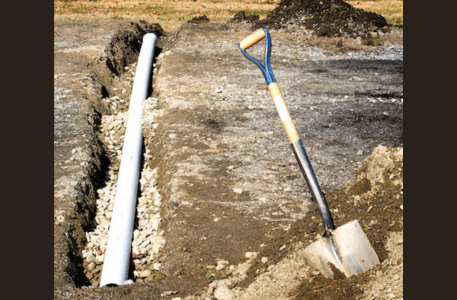
8 FAQs about French Drains
Water is a crucial resource. But if a heavy rain brings too much water, it can saturate your yard or seep into your house, potentially causing significant damage. A French drain may be a practical solution to protect your home and eliminate unwanted groundwater.
1. What’s a French drain?
A French drain is an underground trench that collects and redirects water. The trench is filled with a perforated pipe, often wrapped in water-permeable fabric and suspended within several layers of stone.
French drains go by several other names, including weeping tile, trench drains, rock drains, sub-surface drains, and more.
2. What are the primary benefits of French drains?
If a French drain is connected to one or more downspouts, it can help divert one of the most common sources of water damage away from your home’s foundation.
You can also use a French drain to eliminate puddles of water or soggy spots in your yard, removing a breeding ground for mosquitoes.
Also, when you’re ready to sell your home, a French drain helps potential buyers recognize that you’ve cared for your home and invested in maintaining it well.
3. How do you build a French drain?
There are numerous ways to create a French drain system, but they are typically assembled like this:
- FIrst, a trench is dug with a gentle downward slope, roughly one inch every eight to ten feet. A layer of gravel is spread over the bottom of the trench.
- Next, a perforated pipe (corrugated plastic or PVC) is laid on the gravel bed. Corrugated plastic pipe is flexible and easier to work with, but PVC is more durable.
- More stone is added, burying the pipe.
- Frequently, water-permeable landscape fabric is wrapped around the pipe or lines the trench, so it's harder for dirt to clog the system.
- French drains can terminate in various ways, including flowing into a municipal drain system or accumulating water underground in a dry well.
4. How are French drains finished at the surface?
A French drain pipe can be buried anywhere from 8 inches to 2 feet below the surface. After the stone and pipe have been positioned, some homeowners fill the remaining space with soil and plant grass seed or sod so the trench “disappears” and visually blends into the lawn.
Another option is to finish the trench with decorative stone, giving the appearance of a dry creek bed.
When you finish your French drain, you’ll probably have plenty of extra dirt, so consider how to use that excess soil. A raised garden bed is one good option.
5. Is a French drain a good DIY project?
You don’t need specialized skills to build a French drain, but it can be labor-intensive, especially if it covers a long distance and requires hundreds of pounds of gravel. For example, you may want to rent trenching equipment instead of digging by hand.
You’ll also need to identify a local source and estimate how much gravel you’ll need, either paying someone to deliver the stone or hauling it yourself.
Alternatively, you can hire a contractor to complete the job. According to Angi, French drains can cost as little as $500 to as much as $18,000.
6. How long do French drains last?
It depends. French drains are passive systems without moving parts that could break or corrode. That helps them last a long time. But they are vulnerable to clogging, especially if you don’t take steps to prevent debris from accumulating inside the drain pipe.
A pressure washer is an easy and practical way to clean a clogged French drain.
7. What are other options for managing excessive water in my yard?
Homeowners can rely on various strategies for storing or diverting the water that falls on their roofs and yards.
If you want to harvest the water, a rain barrel is a simple and cost-effective way to collect water from a downspout and use it to water plants in your yard. Just make sure you disperse the water, or you’ll run the risk of a heavy downpour overflowing the barrel.
Alternatively, if your primary objective is improving water drainage in your yard, a rain garden might be an excellent solution.
8. Do I need a permit for a French drain?
The answer depends on where you live and the size of your project. Urban and suburbun municipalities may want to review and approve your plans if they are concerned about stormwater runoff systems becoming overwhelmed. On the other hand, rural residents will encounter few, if any, regulations.
Before starting any digging project, be sure you’ve pinpointed the location of your utility lines to avoid them. The national call-before-you-dig line is 811, or you can visit call811.com to identify your local 811 center.
